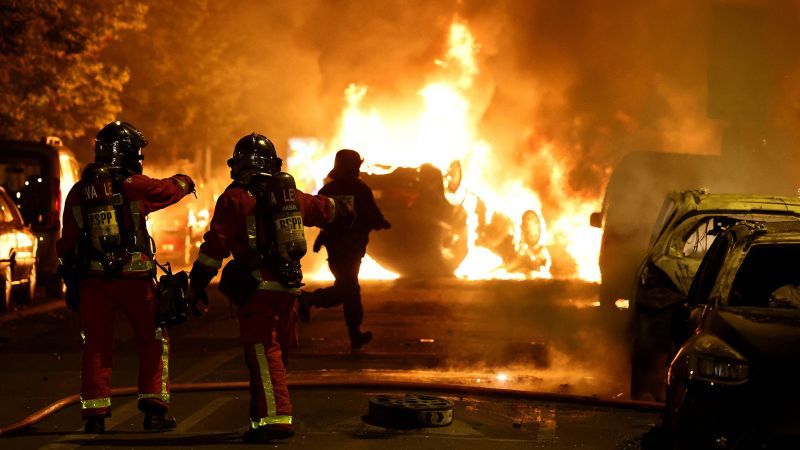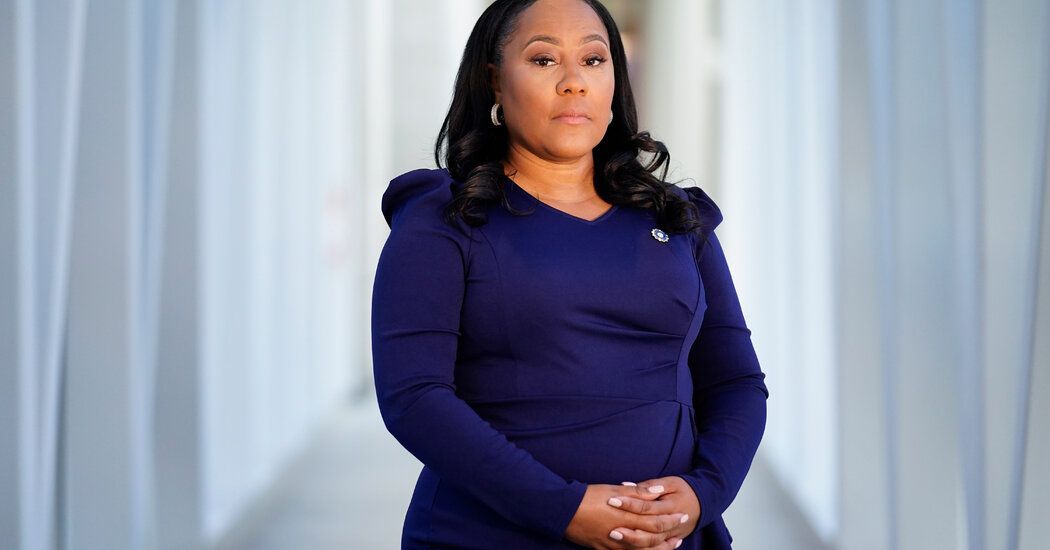France protests: Nationwide demonstrations are sweeping the country. Here's what you need to know
CNN —
France has been rocked by a wave of protests after a 17-year-old youth was shot by police near Paris Tuesday, sparking a ban on demonstrations in some cities, travel warnings and reigniting a debate on overpolicing in marginalized communities.
Scenes emerged of people setting fires to vehicles and climbing onto buildings with smashed windows, while riot police officers fiercely clashed with demonstrators.
The unrest prompted a crisis response from French President Emmanuel Macron, who held an emergency meeting with ministers as he attempts to bridge divisions and unite the country in his second term.
Here’s what we know.
What sparked the protests?
A police officer shot dead the teenager, Nahel, who was of Algerian heritage, during a traffic stop in the Paris suburb of Nanterre earlier this week.
Footage of the incident captured by a passerby showed two officers standing on the driver’s side of the car, one of whom discharged his gun at the driver despite not appearing to face any immediate threat.
The officer said he fired his gun because he was scared the boy would run someone over with the car, Nanterre prosecutor Pascal Prache said.
Prache said that it is believed the officer acted illegally in using his weapon. He is currently facing a formal investigation for voluntary homicide and has been placed in preliminary detention.
Protesters clash with police in Nanterre, France, on Friday, June 30. Gonzalo Fuentes/Reuters A firefighter extinguishes a car that was burnt during clashes between protesters and police in Roubaix, France, on June 30. Pascal Rossignol/Reuters People walk past a vandalized shop in Lille, France, on June 30. Pascal Rossignol/Reuters Burnt buses can be seen through the gates at the Fort d'Aubervilliers bus terminal in Aubervilliers, France, on June 30. Bertrand Guay/AFP/Getty Images Protesters clash with police in Nanterre on June 30. Gonzalo Fuentes/Reuters Fireworks explode as policemen stand by during protests in Roubaix on June 30. Kenzo Tribouillard/AFP/Getty Images People look at burning tires blocking a street in Bordeaux, France, on Thursday, June 29. Philippe Lopez/AFP/Getty Images Demonstrators clash with police in Paris on June 29. Firas Abdullah/Anadolu Agency/Getty Images Cars burn in Nanterre on June 29. Bertrand Guay/AFP/Getty Images Police face protesters at the end of a march in Paris on June 29. Zakaria Abdelkafi/AFP/Getty Images People demonstrate in Nanterre on June 29. Benjamin Girette/Bloomberg/Getty Images Firefighters try to extinguish burning cars in Paris on June 29. Firas Abdullah/Anadolu Agency/Getty Images Mounia, Nahel's mother, gestures as she stands on a truck during a march in Nanterre on June 29. Antoine Gyori/Corbis/Getty Images Firefighters extinguish burning vehicles during clashes in Nanterre on Wednesday, June 28. Stephanie Lecocq/Reuters In pictures: Protests erupt across France after police shooting Prev Next
What’s happened since?
Anger over Nahel’s death exploded into widespread demonstrations and successive nights of violence across France.
Authorities mobilized 40,000 police officers and paramilitary on Thursday to patrol parts of the country including the cities of Bordeaux, Lyon, Roubaix, Marseille and Lille. In Paris alone, 5,000 security personnel were deployed. Officers were given powers to quell riots, make arrests, and “restore republican order,” French Interior Minister Gerard Darmanin said.
Several hundred people were arrested, and more than 200 police officers were injured. Almost 200 government buildings have been vandalized, including police and paramilitary stations, town halls and schools.
What does this mean for Macron?
Macron held an emergency meeting with ministers for the second day in a row, CNN affiliate BFMTV reported, calling the situation “unacceptable” and “unjustifiable.”
The French president cut short his attendance at a European Council summit in Brussels that was due to last through Friday, the Elysee Palace told CNN, instead returning to Paris.
He said a third of the almost 900 people detained overnight were young, in some cases “very young” and urged parents to take responsibility and “keep them at home.”
French President Emmanuel Macron (center) held a crisis meeting, in Paris, on Friday, after the police shooting of a teenage boy triggered protests. Yves Herman/AFP/Getty Images
Macron called for social media platforms to help quell the demonstrations, asking TikTok and Snapchat to withdraw the “most sensitive content” and to identify users who employ “social networks to call for disorder or to exacerbate violence.”
He also announced a ban on all “large-scale events” in France, including “celebratory events and numerous gatherings.”
The announcement came hours after Macron attended an Elton John concert in Paris on Wednesday, even as the demonstrations spiraled.
His government will try to avoid a repeat of 2005, when the deaths of two teenage boys hiding from police set off a state of emergency amid three weeks of rioting.
What led to the unrest?
Activists believe Nahel’s race was a factor in his killing, unraveling deep-rooted tensions over police discrimination against minoritized communities in France.
Secularism – known as “laïcité” in French – is a key foundation of French culture, as it seeks to uphold equality for all by erasing markers of difference, including race.
But many people of color in France say they are more likely to be victims of police brutality than White people. A 2017 study by the Rights Defenders, an independent human rights watchdog in France, found that young men perceived to be Black or Arab were 20 times more likely to be stopped by police than their peers.
The UN called on France to address “deep issues of racism and discrimination in law enforcement,” in the agency’s first comments since the killing.
In a statement on Friday, a spokesperson for the UN High Commissioner for Human Rights urged French authorities to “ensure use of force by police to address violent elements in demonstrations always respects the principles of legality, necessity, proportionality, non-discrimination, precaution and accountability.”
Anti-discrimination campaigners say Nahel's race was a factor in his death. Family Handout via Twitter
The French Ministry of Foreign Affairs later rebuffed the UN’s comments, saying: “France, and its police forces, fight with determination against racism and all forms of discrimination. There can be no doubt about this commitment.
“The use of force by the national police and gendarmerie is governed by the principles of absolute necessity and proportionality, strictly framed and controlled,” the ministry added.
Is it safe to travel to France?
As peak travel season gets underway, multiple countries issued stark warnings to those visiting France, where domestic transport networks have been disrupted.
The Interior Ministry announced that public transportation, including buses and tramways, would shut down across the country by 9 p.m. local time (3 p.m. ET), ahead of a fourth night of expected protests.
Limited curfews were imposed in Clamart and Neuilly-sur-Marne, while some bus services were disrupted in Paris but the Metro system was operating as normal. The Nanterre-Préfecture train station was closed.
In Lille, bus and tramway services were more or less running normally on Friday, with some diversions in place.
In the southern city of Marseille, public transport was due to stop services at 7 p.m.
There was no disruption to the Eurostar service connecting London, Lille and Paris as a result of the protests. French intercity trains are also not affected.
Further afield, the US State Department issued a security alert on June 29 covering France. It suggested monitoring media outlets France24, RFI and The Local for updates.
Meanwhile, Britain issued a travel advisory urging tourists to “monitor the media” and “avoid areas where riots are taking place.”
German authorities also advised its citizens to “find out about the current situation where you are staying at and avoid large-scale places of violent riots.”
Source: CNN


